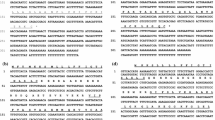Abstract
Novel peptides were identified in the skin secretion of the tree frog Hyla savignyi. Skin secretions were collected by mild electrical stimulation. Peptides were separated by reversed-phase high-performance liquid chromatography. Mass spectra were acquired by electrospray ionization Fourier transform ion cyclotron resonance mass spectrometry (FTICR-MS), and fragment ion spectra were obtained after collision-induced dissociation and electron capture dissociation. Peptides were analyzed by manual de novo sequencing and composition-based sequencing (CBS). Sequence analyses of three so far undescribed, structurally unrelated peptides are presented in this paper, having the sequences DDSEEEEVE-OH, P*EEVEEERJK-OH, and GJJDPJTGJVGGJJ-NH2. The glutamate-rich sequences are assumed to be acidic spacer peptides of the prepropeptide. One of these peptides contains the modified amino acid hydroxyproline, as identified and localized by high-accuracy FTICR-MS. Combination of CBS and of experience-based manual sequence analysis as complementary and database-independent sequencing strategies resulted in peptide identification with high reliability.

So-far unknown natural frog skin peptides were identified by high-resolution CID and ECD MS/MS and by composition-based de novo sequencing. Sequences were confirmed by comparison of MS/MS spectra with synthesized analogs






Similar content being viewed by others
References
Erspamer V, Erspamer GF, Mazzanti G, Endean R (1984) Active peptides in the skins of one hundred amphibian species from Australia and Papua New Guinea. Comp Biochem Physiol 77C:99–108
Erspamer V, Erspamer GF, Cei JM (1986) Active peptides in the skins of two hundred and thirty American amphibian species. Comp Biochem Physiol 85C:125–137
Habermehl G (1969) Chemie und Biochemie von Amphibiengiften. Naturwissenschaften 56:615–622
Gomes A, Giri B, Saha A, Mishra R, Dasgupta SC, Debnath A, Gomes A (2007) Bioactive molecules from amphibian skin: their biological activities with reference to therapeutic potentials for possible drug development. Indian J Exp Biol 45:579–593
Li J, Xu X, Xu C, Zhou W, Zhang K, Yu H, Zhang Y, Zheng Y, Rees HH, Lai R, Yang D, Wu J (2007) Anti-infection peptidomics of amphibian skin. Mol Cell Proteomics 6:882–894
Nascimento ACC, Fontes W, Sebben A, Castro MS (2003) Antimicrobial peptides from anurans skin secretions. Prot Pep Lett 10:227–238
Simmaco M, Mignogna G, Barra D (1998) Antimicrobial peptides from amphibian skin: what do they tell us? Biopolymers 47:435–450
VanCompernolle SE, Taylor RJ, Oswald-Richter K, Jiang J, Youree BE, Bowie JH, Tyler MJ, Conlon JM, Wade D, Aiken C, Dermody TS, KewalRamani VN, Rollins-Smith LA, Unutmaz D (2005) Antimicrobial peptides from amphibian skin potently inhibit human immunodeficiency virus infection and transfer of virus from dendritic cells to T cells. J Virol 79:11598–11606
Chinchar VG, Bryan L, Silphadaung U, Noga E, Wade D, Rollins-Smith L (2004) Inactivation of viruses infecting ectothermic animals by amphibian and piscine antimicrobial peptides. Virology 323:268–275
Lu CX, Nan KJ, Lei Y (2008) Agents from amphibians with anticancer properties. Anticancer Drugs 19:931–939
Shai Y (1999) Mechanism of the binding, insertion and destabilization of phospholipid bilayer membranes by α-helical antimicrobial and cell non-selective membrane-lytic peptides. Biochim Biophys Acta 1462:55–70
Matsuzaki K (1999) Why and how are peptide-lipid interactions utilized for self-defense? Magainins and tachyplesins as archetypes. Biochim Biophys Acta 1462:1–10
Brogden KA (2005) Antimicrobial peptides: pore formers or metabolic inhibitors in bacteria? Nat Rev Microbiol 3:238–250
Matyus E, Kandt C, Tieleman DP (2007) Computer simulation of antimicrobial peptides. Curr Med Chem 14:2789–2798
Wang Z, Wang G (2004) APD: the antimicrobial peptide database. Nucleic Acids Res 32:D590–D592
Wang G, Li X, Wang Z (2009) APD2: the updated antimicrobial peptide database and its application in peptide design. Nucleic Acids Res 37:D933–D937
Koczulla AR, Bals R (2003) Antimicrobial peptides. Drugs 63:389–406
Gordon YJ, Romanowski EG (2005) A review of antimicrobial peptides and their therapeutic potential as anti-infective drugs. Curr Eye Res 30:505–515
Pukala TL, Bowie JH, Maselli VM, Musgrave IF, Tyler MJ (2006) Host-defence peptides from the glandular secretions of amphibians: structure and activity. Nat Prod Rep 23:368–393
Apponyi MA, Pukala TL, Brinkworth CS, Maselli VM, Bowie JH, Tyler MJ, Booker GW, Wallace JC, Carver JA, Separovic F, Doyle J, Llewellyn LE (2004) Host-defence peptides of Australian anurans: structure, mechanism of action and evolutionary significance. Peptides 25:1035–1054
Langsdorf M, Ghassempour A, Roempp A, Spengler B (2010) Characterization of a peptide family from the skin secretion of the middle east tree frog Hyla savignyi by composition-based de novo sequencing using positive and negative ion mass spectrometry. Rapid Commun Mass Spectrom. doi:10.1002/rcm.4717
Steinborner ST, Wabnitz PA, Waugh RJ, Bowie JH, Gao CW, Tyler MJ, Wallace JC (1996) The structures of new peptides from the Australian red tree frog ‘Litoria rubella’. The skin peptide profile as a probe for the study of evolutionary trends of amphibians. Aust J Chem 49:955–963
Wabnitz PA, Bowie JH, Wallace JC, Tyler MJ (1999) Peptides from the skin glands of the Australian buzzing tree frog Litoria electrica. Comparison with the skin peptides of the red tree frog Litoria rubella. Aust J Chem 52:639–645
Renda T, D’Este L, Buffa R, Usellini L, Capella C, Vaccaro R, Melchiorri P (1985) Tryptophyllin-like immunoreactivity in rat adenohypophysis. Peptides 6:197–202
Papayannopoulos IA (1995) The interpretation of collision-induced dissociation tandem mass spectra of peptides. Mass Spectrom Rev 14:49–73
Horn DM, Zubarev RA, McLafferty FW (2000) Automated de novo sequencing of proteins by tandem high-resolution mass spectrometry. PNAS 97:10313–10317
Samgina TY, Artemenko AK, Gorshkov VA, Poljakov NB, Lebedev AT (2008) Oxidation versus carboxamidomethylation of S–S bond in Ranid frog peptides: pro and contra for de novo MALDI-MS sequencing. J Am Soc Mass Spectrom 19:479–487
Chen W, Lee PJ, Shion H, Ellor N, Gebler JC (2007) Improving de novo sequencing of peptides using a charged tag and C-terminal digestion. Anal Chem 79:1583–1590
Thieu VA, Kirsch D, Flad T, Mueller C, Spengler B (2006) Direct protein identification from nonspecific peptide pools by high-accuracy MS data filtering. Angew Chem Int Ed 45:3317–3319
Spengler B, Luetzenkirchen F, Metzger S, Chaurand P, Kaufmann R, Jeffery W, Bartlet-Jones M, Pappin DJC (1997) Peptide sequencing of charged derivatives by postsource decay MALDI mass spectrometry. Int J Mass Spectrom Ion Process 169/170:127–140
Harrison AG, Young AB, Bleiholder C, Suhai S, Paizs B (2006) Scrambling of sequence information in collision-induced dissociation of peptides. J Am Chem Soc 128:10364–10365
Jia C, Qi W, He Z (2007) Cyclization reaction of peptide fragment ions during multistage collisionally activated decomposition: an inducement to lose internal amino-acid residues. J Am Soc Mass Spectrom 18:663–678
Unnithan AG, Myer MJ, Veale CJ, Danell AS (2007) MS/MS of protonated polyproline peptides: the influence of N-terminal protonation on dissociation. J Am Soc Mass Spectrom 18:2198–2203
Harrison AG, Young AB (2005) Fragmentation reactions of deprotonated peptides containing proline. The proline effect. J Mass Spectrom 40:1173–1186
Grewal RN, El Aribi H, Harrison AG, Siu KWM, Hopkinson AC (2004) Fragmentation of protonated tripeptides: the proline effect revisited. J Phys Chem B 108:4899–4908
Schwartz BL, Bursey MM (1992) Some proline substituent effects in the tandem mass spectrum of protonated pentaalanine. Biol Mass Sectrom 21:92–96
Kaufmann R, Chaurand P, Kirsch D, Spengler B (1996) Post-source decay and delayed extraction in matrix-assisted laser desorption/ionization-reflectron time-of-flight mass spectrometry. Are there trade-offs? Rapid Commun Mass Spectrom 10:1199–1208
Spengler B (2004) De novo sequencing, peptide composition analysis, and composition-based sequencing: a new strategy employing accurate mass determination by Fourier transform ion cyclotron resonance mass spectrometry. J Am Soc Mass Spectrom 15:703–714
Roepstorff P, Fohlmann J (1984) Proposal for a common nomenclature for sequence ions in mass spectra of peptides. Biomed Mass Spectrom 11:601
Johnson RS, Martin SA, Biemann K (1988) Collision-induced fragmentation of (M+H)+ ions of peptides. Side chain specific sequence ions. Int J Mass Spectrom Ion Proc 86:137–154
Schlosser A, Lehmann WD (2002) Patchwork peptide sequencing: extraction of sequence information from accurate mass data of peptide tandem mass spectra recorded at high resolution. Proteomics 2:524–533
Schatz G, Dobberstein B (1996) Common principles of protein translocation across membranes. Science 271:1519–1526
Pfanner N, Geissler A (2001) Versatility of the mitochondrial protein import machinery. Nat Rev Mol Cell Biol 2:339–349
Acknowledgments
We would like to thank Faraham Ahmadzadeh and Hossein Hashempour from Shahid Beheshti University, Tehran, for collecting the skin secretions. Financial support by the Deutsche Forschungsgemeinschaft (DFG, Sp314/10-1) and by the Bundesministerium für Bildung und Forschung (BMBF, NGFN project 0313442) is gratefully acknowledged.
This publication represents a component of the doctoral (Dr. rer. nat.) thesis of Markus Langsdorf in the Faculty of Biology and Chemistry at the Justus Liebig University Giessen, Germany.
Author information
Authors and Affiliations
Corresponding author
Additional information
Published in the special issue Mass Spectrometry (DGMS 2010) with Guest Editors Andrea Sinz and Jürgen Schmidt.
Electronic supplementary material
Below is the link to the electronic supplementary material.
ESM 1
(PDF 558 kb)
Rights and permissions
About this article
Cite this article
Langsdorf, M., Ghassempour, A., Römpp, A. et al. Isolation and sequence analysis of peptides from the skin secretion of the Middle East tree frog Hyla savignyi . Anal Bioanal Chem 398, 2853–2865 (2010). https://doi.org/10.1007/s00216-010-4131-8
Received:
Revised:
Accepted:
Published:
Issue Date:
DOI: https://doi.org/10.1007/s00216-010-4131-8




